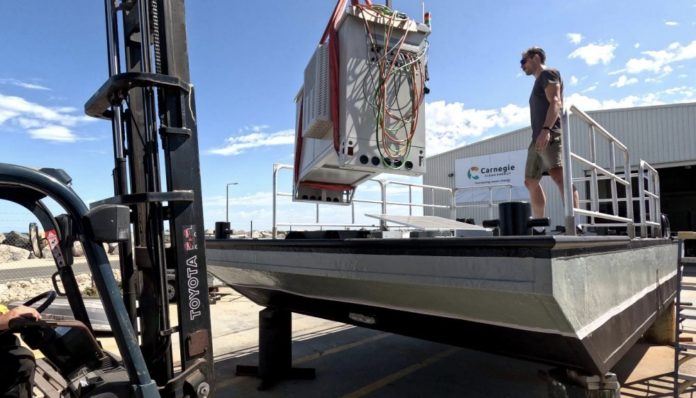Project utilizes the natural movement of ocean swells to generate electricity on feed barges.
Australian technology firm Carnegie Clean Energy (CCE) has developed a mechanism that converts the motion of salmon feed barges into electrical power, potentially replacing the need for fossil fuels.
This initiative, aimed at reducing the carbon footprint of aquaculture, and first reported on by SalmonBusiness in 2021, has recently undergone successful testing with Tasmanian salmon producers Huon and Tassal.
The project, named MoorPower utilizes the natural movement of ocean swells, ranging from gentle to more challenging conditions, to generate electricity on floating salmon farms.
CCE’s past efforts have focused on hectare-sized wave farms of units that could produce enough electricity to power 10,000 households. But the latest module works on the surface and at a smaller scale than other trials the company has underway in Europe.
Following the deployment in January, the MoorPower demonstrator project is expected to yield vital insights into the behavior of the system across various sea conditions. These results will play a crucial role in confirming the operational effectiveness of the MoorPower technology and validating the previously completed numerical simulations, according to CCE.
“We have listened to the needs of industry operating in isolated offshore environments and adapted our unique CETO technology to their requirements,” chief executive Jonathan Fievez said.
In a recent quarterly presentation, Huon Aquaculture’s General Manager of Sustainability, Matthew Whittle, acknowledged the project’s role in meeting emission reduction targets and aligning with sustainable business practices.
Salmon farming was already one of the most efficient ways of using natural resources to produce healthy proteins, according to Huon’s sustainability lead, Matthew Whittle.
“Projects like this will enable us to continue driving efficiencies to achieve our emission reduction targets while meeting community and consumer expectations for sustainable business practices,” he said.

